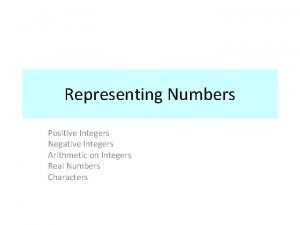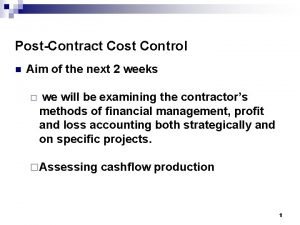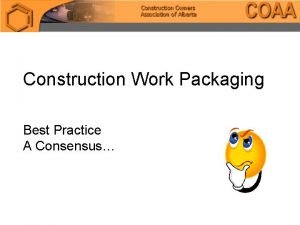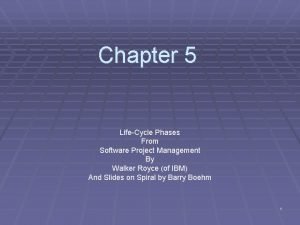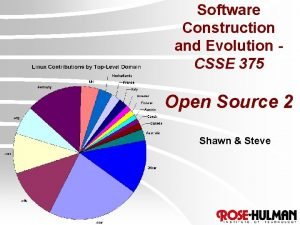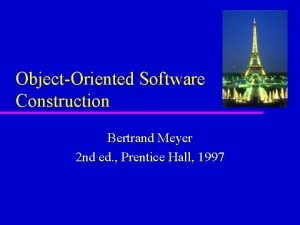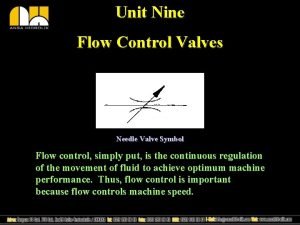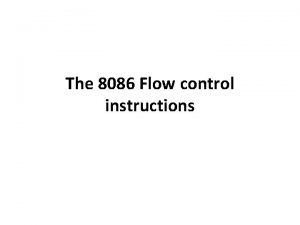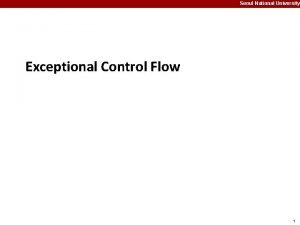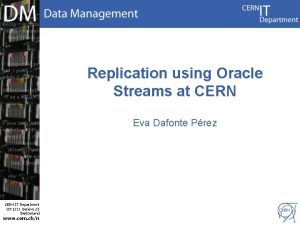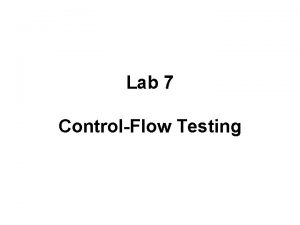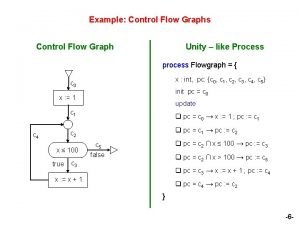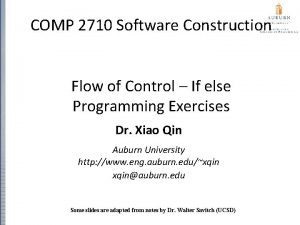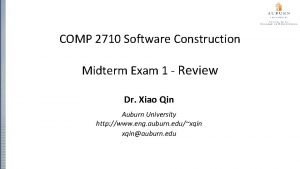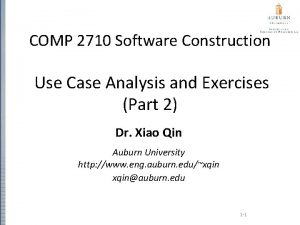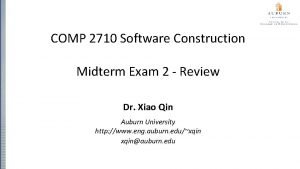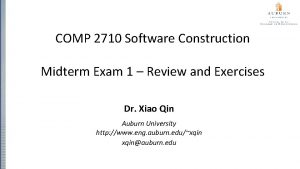COMP 2710 Software Construction Flow of Control Dr







































- Slides: 39

COMP 2710 Software Construction Flow of Control Dr. Xiao Qin Auburn University http: //www. eng. auburn. edu/~xqin@auburn. edu Some slides are adapted from notes by Dr. Walter Savitch (UCSD)

Objectives • Boolean Expressions – Building, Evaluating & Precedence Rules • Branching Mechanisms – if-else – switch – Nesting if-else • Loops – While, do-while, for – Nesting loops Copyright © 2008 Pearson Addison-Wesley. All rights reserved. 2 -2

Boolean Expressions: Display 2. 1 Comparison Operators • Logical Operators – Logical AND (&&) – Logical OR (||) Copyright © 2008 Pearson Addison-Wesley. All rights reserved. 2 -3

Evaluating Boolean Expressions • Data type bool – Returns true or false – true, false are predefined library consts • Truth tables – Display 2. 2 next slide Copyright © 2008 Pearson Addison-Wesley. All rights reserved. 2 -4

Evaluating Boolean Expressions: Display 2. 2 Truth Tables Copyright © 2008 Pearson Addison-Wesley. All rights reserved. 2 -5

Display 2. 3 Precedence of Operators (1 of 4) Copyright © 2008 Pearson Addison-Wesley. All rights reserved. 2 -6

Display 2. 3 Precedence of Operators (2 of 4) Copyright © 2008 Pearson Addison-Wesley. All rights reserved. 2 -7

Display 2. 3 Precedence of Operators (3 of 4) Copyright © 2008 Pearson Addison-Wesley. All rights reserved. 2 -8

Display 2. 3 Precedence of Operators (4 of 4) Copyright © 2008 Pearson Addison-Wesley. All rights reserved. 2 -9

Precedence Examples • Arithmetic before logical – x + 1 > 2 || x + 1 < -3 means: • (x + 1) > 2 || (x + 1) < -3 • Short-circuit evaluation – (x >= 0) && (y > 1) – Be careful with increment operators! • (x > 1) && (y++) • Integers as boolean values – All non-zero values true – Zero value false Copyright © 2008 Pearson Addison-Wesley. All rights reserved. 2 -10

Branching Mechanisms • if-else statements – Choice of two alternate statements based on condition expression – Example: if (hrs > 40) gross. Pay = rate*40 + 1. 5*rate*(hrs-40); else gross. Pay = rate*hrs; Copyright © 2008 Pearson Addison-Wesley. All rights reserved. 2 -11

if-else Statement Syntax • Formal syntax: if (<boolean_expression>) <yes_statement> else <no_statement> • Note each alternative is only ONE statement! • To have multiple statements execute in either branch use compound statement Copyright © 2008 Pearson Addison-Wesley. All rights reserved. 2 -12

Compound/Block Statement • Only "get" one statement per branch • Must use compound statement { } for multiples – Also called a "block" stmt • Each block should have block statement – Even if just one statement – Enhances readability Copyright © 2008 Pearson Addison-Wesley. All rights reserved. 2 -13

Compound Statement in Action • Note indenting in this example: if (my. Score > your. Score) { cout << "I win!n"; wager = wager + 100; } else { cout << "I wish these were golf scores. n"; wager = 0; } Copyright © 2008 Pearson Addison-Wesley. All rights reserved. 2 -14

Common Pitfalls • Operator "=" vs. operator "==" • One means "assignment" (=) • One means "equality" (==) – VERY different in C++! – Example: x = 11; if (x = 12) Note operator used! Do_Something else Do_Something_Else Copyright © 2008 Pearson Addison-Wesley. All rights reserved. 2 -15

The Optional else • else clause is optional – If, in the false branch (else), you want "nothing" to happen, leave it out – Example: if (sales >= minimum) salary = salary + bonus; cout << "Salary = %" << salary; – Note: nothing to do for false condition, so there is no else clause! – Execution continues with cout statement Copyright © 2008 Pearson Addison-Wesley. All rights reserved. 2 -16

Nested Statements • if-else statements contain smaller statements – Compound or simple statements (we’ve seen) – Can also contain any statement at all, including another ifelse stmt! – Example: speed = 56; if (speed > 55) if (speed > 80) cout << "You’re really speeding!"; else cout << "You’re speeding. "; • Note proper indenting! Copyright © 2008 Pearson Addison-Wesley. All rights reserved. 2 -17

Multiway if-else: Display, page 63 • Not new, just different indenting • Avoids "excessive" indenting – Syntax: Copyright © 2008 Pearson Addison-Wesley. All rights reserved. 2 -18

Multiway if-else Example: Display, page 63 Copyright © 2008 Pearson Addison-Wesley. All rights reserved. 2 -19

The switch Statement • A new stmt for controlling multiple branches • Uses controlling expression which returns bool data type (true or false) • Syntax: – Display page 62 next slide Copyright © 2008 Pearson Addison-Wesley. All rights reserved. 2 -20

switch Statement Syntax: Display, page 64 Copyright © 2008 Pearson Addison-Wesley. All rights reserved. 2 -21

The switch Statement in Action: Display, page 64 Copyright © 2008 Pearson Addison-Wesley. All rights reserved. 2 -22

The switch: multiple case labels • Execution "falls thru" until break – switch provides a "point of entry" – Example: case "A": case "a": cout << "Excellent: you got an "A"!n"; break; case "B": case "b": cout << "Good: you got a "B"!n"; break; – Note multiple labels provide same "entry" Copyright © 2008 Pearson Addison-Wesley. All rights reserved. 2 -23

Summary • Boolean expressions – Similar to arithmetic results in true or false • C++ branching statements – if-else, switch – switch statement great for menus • Next Time: C++ loop statements – while – do-while – for Copyright © 2008 Pearson Addison-Wesley. All rights reserved. 2 -24

Loops • 3 Types of loops in C++ – while • Most flexible • No "restrictions" – do-while • Least flexible • Always executes loop body at least once – for • Natural "counting" loop Copyright © 2008 Pearson Addison-Wesley. All rights reserved. 2 -25

while Loops Syntax Copyright © 2008 Pearson Addison-Wesley. All rights reserved. 2 -26

while Loop Example • Consider: count = 0; while (count < 3) { cout << "Hi "; count++; } // Initialization // Loop Condition // Loop Body // Update expression Loop body executes how many times? Copyright © 2008 Pearson Addison-Wesley. All rights reserved. 2 -27

do-while Loop Syntax Often used for menu applications. Why? Copyright © 2008 Pearson Addison-Wesley. All rights reserved. 2 -28

do-while Loop Example • count = 0; // Initialization do { cout << "Hi "; // Loop Body count++; // Update expression } while (count < 3); // Loop Condition – Loop body executes how many times? – do-while loops always execute body at least once! Copyright © 2008 Pearson Addison-Wesley. All rights reserved. 2 -29

while vs. do-while • Very similar, but… – One important difference • Issue is "WHEN" boolean expression is checked • while: checks BEFORE body is executed • do-while: checked AFTER body is executed • After this difference, they’re essentially identical! • while is more common, due to it’s ultimate "flexibility" Copyright © 2008 Pearson Addison-Wesley. All rights reserved. 2 -30

Comma Operator • Evaluate list of expressions, returning value of the last expression • Most often used in a for-loop • Example: first = (first = 2, second = first + 1); – first gets assigned the value 3 – second gets assigned the value 3 • No guarantee what order expressions will be evaluated. Copyright © 2008 Pearson Addison-Wesley. All rights reserved. 2 -31

for Loop Syntax for (Init_Action; Bool_Exp; Update_Action) Body_Statement • Like if-else, Body_Statement can be a block statement – Much more typical Copyright © 2008 Pearson Addison-Wesley. All rights reserved. 2 -32

for Loop Example • for (count=0; count<3; count++) { cout << "Hi "; // Loop Body } • How many times does loop body execute? • Initialization, loop condition and update all "built into" the for-loop structure! • A natural "counting" loop Copyright © 2008 Pearson Addison-Wesley. All rights reserved. 2 -33

Loop Issues • Loop’s condition expression can be ANY boolean expression • Examples: while (count<3 && done!=0) { // Do something } for (index=0; index<10 && entry!=-99; index++) { // Do something } Copyright © 2008 Pearson Addison-Wesley. All rights reserved. 2 -34

Loop Pitfalls: Misplaced ; • Watch the misplaced ; (semicolon) – Example: while (response != 0) ; { cout << "Enter val: "; cin >> response; } – Notice the "; " after the while condition! • Result here: INFINITE LOOP! Copyright © 2008 Pearson Addison-Wesley. All rights reserved. 2 -35

Loop Pitfalls: Infinite Loops • Loop condition must evaluate to false at some iteration through loop – If not infinite loop. – Example: while (1) { cout << "Hello "; } – A perfectly legal C++ loop always infinite! • Infinite loops can be desirable – e. g. , "Embedded Systems" Copyright © 2008 Pearson Addison-Wesley. All rights reserved. 2 -36

The break and continue Statements • Flow of Control – Recall how loops provide "graceful" and clear flow of control in and out – In RARE instances, can alter natural flow • break; – Forces loop to exit immediately. • continue; – Skips rest of loop body • These statements violate natural flow – Only used when absolutely necessary! Copyright © 2008 Pearson Addison-Wesley. All rights reserved. 2 -37

Nested Loops • Recall: ANY valid C++ statements can be inside body of loop • This includes additional loop statements! – Called "nested loops" • Requires careful indenting: for (outer=0; outer<5; outer++) for (inner=7; inner>2; inner--) cout << outer << inner; – Notice no { } since each body is one statement – Good style dictates we use { } anyway Copyright © 2008 Pearson Addison-Wesley. All rights reserved. 2 -38

Summary - loop • do-while loops – Always execute their loop body at least once • for-loop – A natural "counting" loop • Loops can be exited early – break statement – continue statement – Usage restricted for style purposes Copyright © 2008 Pearson Addison-Wesley. All rights reserved. 2 -39
 2710 19 43
2710 19 43 Negative numbers in ascii
Negative numbers in ascii 2710 gtip
2710 gtip Data flow vs control flow
Data flow vs control flow Control flow and data flow computers
Control flow and data flow computers Transaction flow graph
Transaction flow graph Transform flow and transaction flow
Transform flow and transaction flow Stock control e flow control
Stock control e flow control Error control and flow control
Error control and flow control Post contract cost control in construction
Post contract cost control in construction Construction work package software
Construction work package software Life cycle phases in software project management
Life cycle phases in software project management Evolution construction software
Evolution construction software Software construction in java
Software construction in java Software construction course
Software construction course Evolution construction software
Evolution construction software Bertrand meyer object-oriented software construction
Bertrand meyer object-oriented software construction High flow versus low flow oxygen
High flow versus low flow oxygen Simple mask flow rate
Simple mask flow rate Non rebreather mask definition
Non rebreather mask definition Turbulent flow definition
Turbulent flow definition Internal vs external flow
Internal vs external flow Energy naturally flows from warmer matter to cooler matter.
Energy naturally flows from warmer matter to cooler matter. Oikos meaning
Oikos meaning Transform flow and transaction flow
Transform flow and transaction flow Irrotational flow means *
Irrotational flow means * External flow and internal flow
External flow and internal flow Flow chart of cheese making
Flow chart of cheese making Flow restrictor valve symbol
Flow restrictor valve symbol Flow control udp
Flow control udp Cmp command in 8086
Cmp command in 8086 Seoul national university events
Seoul national university events Repl capture/apply: memory
Repl capture/apply: memory Material flow control
Material flow control Control flow graph for bubble sort
Control flow graph for bubble sort Hydraulic oil pressure symbol
Hydraulic oil pressure symbol Control flow graph examples with solutions
Control flow graph examples with solutions Flow control in database security
Flow control in database security Control valve flow characteristics
Control valve flow characteristics Blood flow control
Blood flow control

